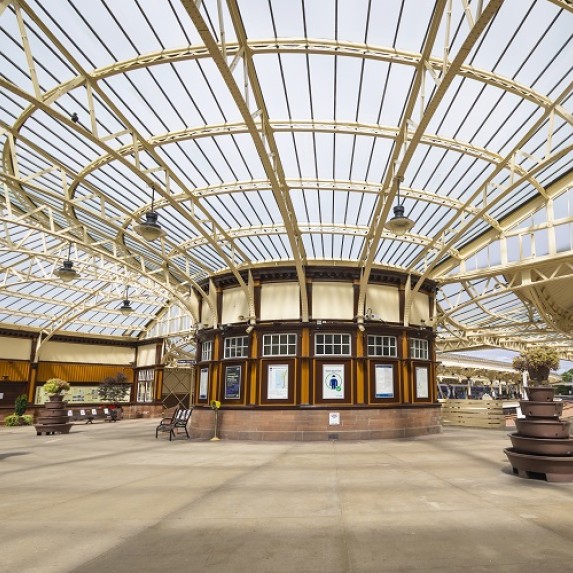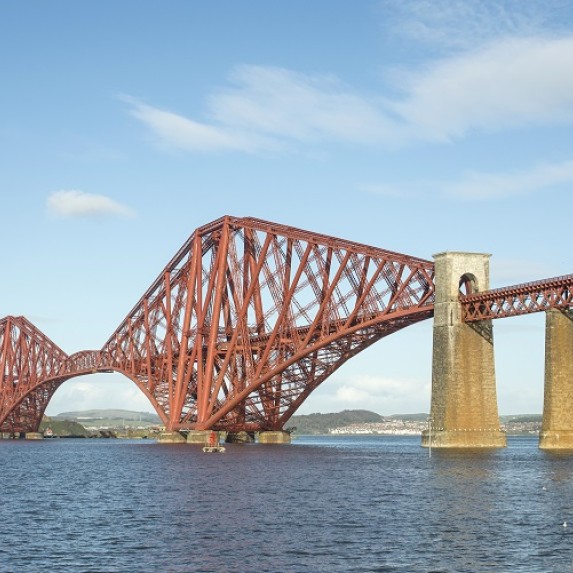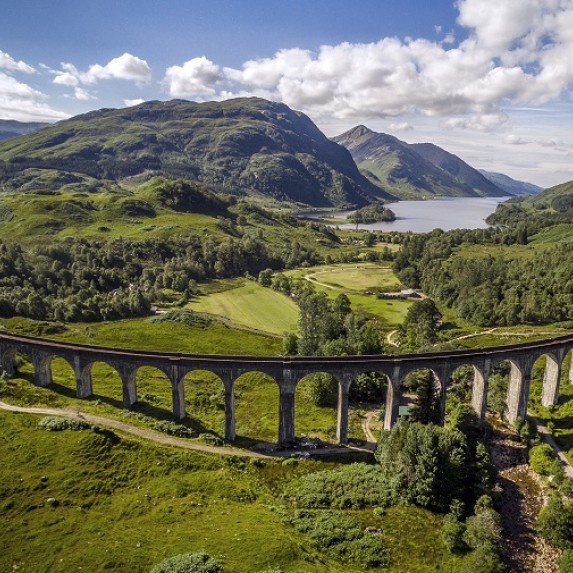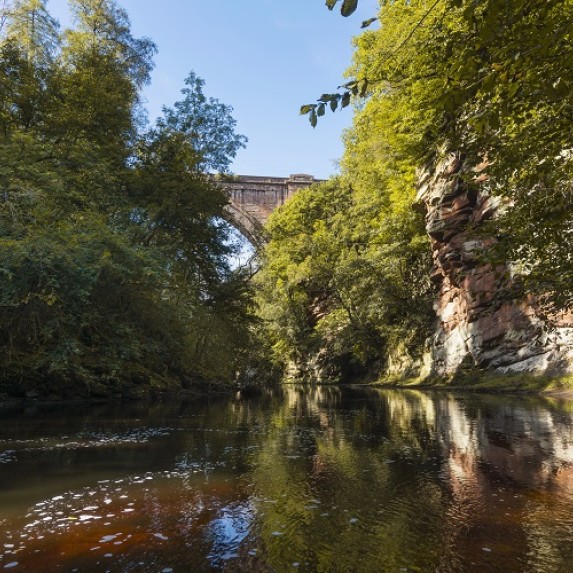'The Architecture the Railways Built’ has become a staple on our tv viewing calendars over the years.
The show has been running for four series covering the incredible sights of the railway across the length and breadth of the UK. And there have been lots of visits to Scotland. The great thing about this programme is that it showcases the expected highlights such as the Forth Bridge but also places that you may not necessarily have paid a lot of attention to before such as Wemyss Bay Station, Connel Bridge, Ballochmyle Viaduct and Laigh Milton Viaduct.
All episodes are available on UKTV Play and if you have a spare hour, we would highly recommend joining railway expert Tim Dunn for a brilliant insight into our railway.
In this blog we’re taking a look at the iconic architecture that has helped to shape Scotland’s Railway.
Wemyss Bay Station
Featured in the first episode of ‘The Architecture the Railways Built’, this stunning station was rebuilt in 1903 by renowned architect James Miller featuring magnificent glazing. Anyone that has ever visited the station will know just how special it is. There are no corners, just gorgeous flowing curved lines to the platforms and down to the ferry that carries passengers over to Rothesay on the Isle of Bute.
One of the most fascinating things about Wemyss Bay Station is that it features a wonderfully unique range of styles. There’s the Chinese influence, found in the pagodas at the ferry end of the station, the Italian clock tower which provides a great photo opportunity on a summer’s evening, and a Georgian style timber frontage.
For a lot of people in the past, Wemyss Bay station was a feature on their summer holidays as they headed off “doon the watter”. Those glory days of holidays are now commemorated with a statue of a boy carrying a model boat.
Another thing that makes the station so special are the fabulous floral displays created by The Friends of Wemyss Bay Station. Every year the station comes alive, as it did in days gone by, with towers of colourful plants and flowers. The group also run the bookshop and gallery at the station.
The Forth Bridge
The Forth Bridge needs no introduction and is synonymous with Scotland’s Railway. It also happens to be one of Scotland’s seven UNESCO World Heritage sites. Opened in 1890, it’s Scotland’s greatest symbol of Victorian engineering and is known to Railway folk, as simply ‘The Bridge.’
The three cantilever, 2,467 metre long structure stands tall at 46 metres high over the Firth of Forth. The striking colour of the bridge is thanks to Network Rail who have lovingly restored the structure in traditional red using techniques developed by the North Sea oil industry.
Building the Forth Bridge back in the 1800’s unfortunately wasn’t without its tragedies and there are memorials below both ends to commemorate those who died in its construction.
The bridge’s plans for the future include a visitor centre at the south end, which will also enable people to undertake a bridge climb, similar to that of the Sydney Harbour Bridge. As you can imagine, the views from the top are incredible so we’re excited for this to open. Even just taking a train ride over the iconic red bridge is a journey to remember.
Check out series 4, episode 1 to discover everything you ever needed to know about this fantastic structure.
The Heilanman’s Umbrella
Glasgow Central station is Scotland’s busiest station with millions of people passing through each year. The wonderfully light and airy station was rebuilt by architect James Miller in 1903. As you approach Central station along Argyle Street, you’ll no doubt have noticed, and probably walked under, the striking glass-sided bridge that carries the platforms south, over Argyle Street. While nowadays it’s a nice shortcut into Central, particularly to get to the Low Level platforms, back in the 1920s and 1930s it was a place for Highlanders to shelter from the harsh Glasgow weather.
It’s thought that once a week, usually on a Saturday, the Highlanders would come together to catch up on each other’s news, gossip and stories about their new lives in the big city. The Umbrella tradition reached its peak between the wars, but due to the blackout during the Second World War, the tradition died.
Nowadays you’ll find a range of shops underneath the bridge including the popular Platform food market.
Glenfinnan Viaduct
Another structure that needs no introduction is the stunning Glenfinnan Viaduct. It’s a true icon of the Scottish Highlands. Nestled in the valley at the top of Loch Shiel in the West Highlands, the viaduct soared up the popularity charts when it was featured in the Harry Potter films as part of the journey to Hogwarts.
When the viaduct was completed by Sir Robert McAlpine (nicknamed Concrete Bob) in 1901, the 21-span structure was the longest mass concrete viaduct in Britain. The viaduct overlooks a statue at the head of Loch Shiel that commemorates the start of the Jacobite uprising led by Bonnie Prince Charlie in 1745.
ScotRail services operate over the Glenfinnan Viaduct all year round as part of the stunning West Highland Line. Between April and October, the line is shared with The Jacobite steam train.
Connel Bridge
Featured in series one, episode two of ‘The Architecture the Railway’s Built’, Connel Bridge is visible from the Glasgow to Oban train at Connel Ferry station, around five miles east of Oban.
Between 1903 and 1966, the cantilever bridge, which was once the longest cantilever bridge in Europe after the Forth Bridge, carried the Ballachulish branch line across the Falls of Lora at the mouth of Loch Etive. Connel Bridge spans 71 metres and was shared by toll-paying road traffic on the A828. The toll was abolished when the railway was removed, but the road is still only wide enough for single vehicles.
Ballochmyle Viaduct
This striking viaduct, on the Glasgow to Carlisle line is the highest surviving viaduct in Britain. Standing 169 feet tall above the Water of Ayr, the viaduct is located between Mauchline and Catrine near Kilmarnock. It’s thought that over its lifetime it has carried tens of thousands of trains.
For many years, since its completion in 1850, the structure was the largest masonry arch in the world. It still remains amongst the biggest masonry arches to have ever been built. It even caught the attention of Hollywood, and features towards the end of the 1996 ‘Mission: Impossible’ film.
Back in the early 2010s, Network Rail strengthened the structure to ensure that it was still strong enough to carry heavy freight trains. Thankfully, this didn’t require any changes to its external appearance.
Laigh Milton Viaduct
The Laigh Milton viaduct can be seen looking north from the Kilmarnock to Stranraer train between Kilmarnock and Troon as the line crosses over the River Irvine. It is thought to be the world’s oldest viaduct on a public railway.
When the viaduct was first opened in 1812, it was for carrying horse drawn wagons across the river. As time went on, the structure was closed in 1846 for work to be carried out to ease the sharp curves that could have caused issues for trains. This resulted in two additional viaducts being built of which only one is still in existence. Laigh Milton viaduct stood undisturbed for one and half centuries until it was restored in 1996.
If you enjoyed this blog post, make sure you keep up to date by signing up to receive our email newsletters. They're packed with fun articles like this plus our latest news, special offers and competitions.





